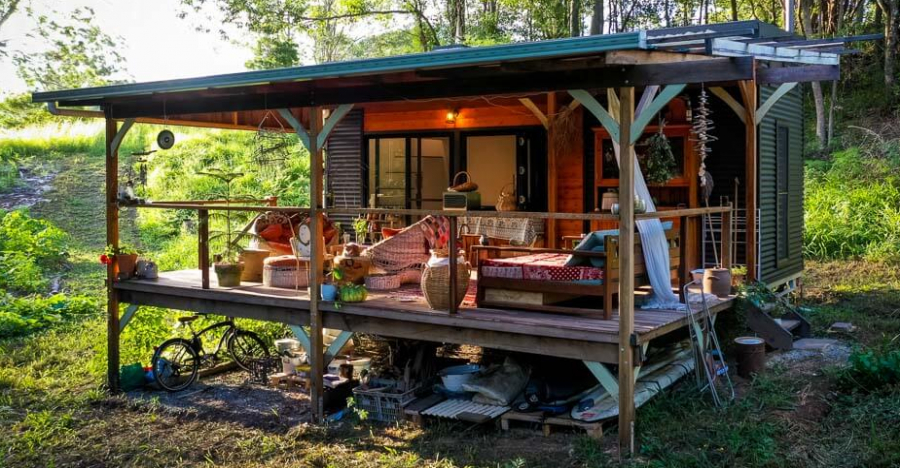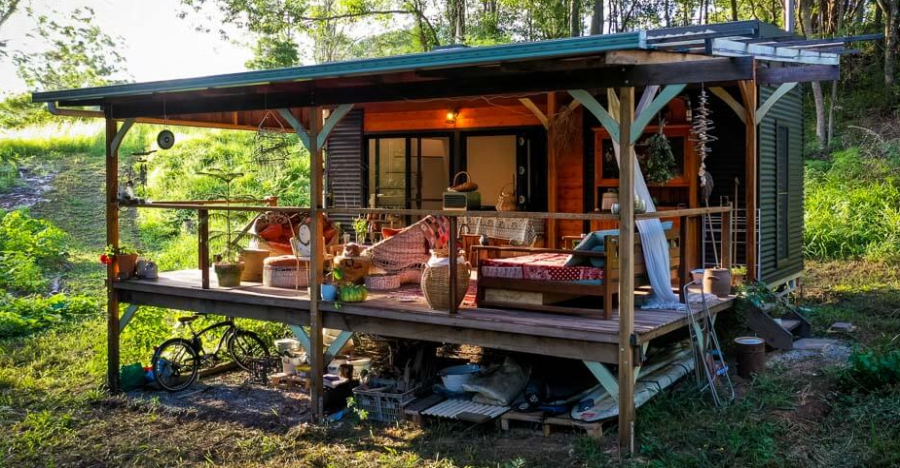You’ll want to watch this 18-minute video that takes you to the beautiful sub-tropical Northern Rivers region of New South Wales to visit a spectacular off-the-grid tiny house on wheels, situated amongst stunning syntropic, regenerative, food forest gardens. For anyone who has ever dreamed of going off the grid and escaping to paradise to grow food and live simply, this is a video tour you will want to watch. The tiny home is 7.2 by 2.4 meters (24 by 8 feet) this tiny house is beautifully designed and built. The tiny house has amazing indoor/outdoor flow, with a giant veranda added on to fully capitalize on the subtropical climate and encourage as much outdoor living as possible.

The tiny home is completely off-the-grid, with solar power and rain-water collection. For Anthony and Kirra, being off the grid was an important part of living with their values, ensuring they were able to live close to nature and use as much clean energy as possible. The tiny home has a composting toilet, reducing water consumption and helping to make off-the-grid living possible, especially in the drought-prone climate. Anthony and Kirra are both passionate about growing as much of their food as possible and have surrounded their tiny house on wheels with syntropic gardens.
Similar in many ways to permaculture, syntropic farming is a form of dynamic regenerative agricultural forestry which uses systems thinking approach to create an abundant, healthy, natural food forest. Focus is placed on the formation of healthy soil biology and establishing microclimates so that food production and agriculture are synchronized with the regeneration of the land. For Anthony, this isn’t his first experience in living tiny. Previously, he lived for 5 years on the road in a converted VW camper van, as he traveled all over Australia educating children on the dangers of plastic pollution and its effects on ocean-life, and encouraging zero waste lifestyle and plastic waste reduction. You can find out more about his Plastic Pollution Solution business here.
Regenerative Agriculture is the type of farming and grazing practice that, among other benefits, reverses climate change by rebuilding soil organic matter and restoring the degraded soil biodiversity which results in both carbon drawdown and improving the water cycle. The loss of the world’s fertile soil and biodiversity, along with the loss of indigenous seeds and knowledge, poses a mortal threat to future survival. According to soil scientists, at the current rates of soil destruction (i.e. decarbonization, erosion, desertification, chemical pollution), within 50 years the planet will not only suffer serious damage to public health due to a qualitatively degraded food supply characterized by diminished nutrition and loss of important trace minerals, but we will no longer have enough arable topsoil to feed ourselves. Without protecting and regenerating the soil on our 4 billion acres of cultivated farmland, 8 billion acres of pastureland, and 10 billion acres of forest land, it will be impossible to feed the world. You’ll want to watch the full video tour of this beautiful tiny house and stunning syntropic food forest garden.









Source: hyggehous.com








